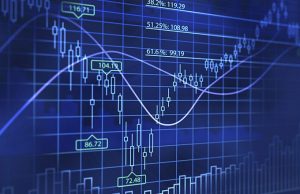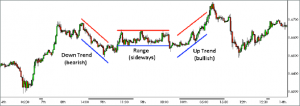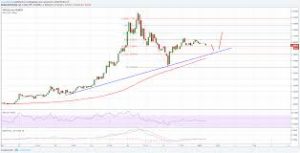
While technical analysis is definitely a useful tool to have, can you really turn a profit through pure technical trading? And how does it work? Even after years of popularity, there are still a lot of myths about technical analysis that have people scratching their heads.
Some people believe that simply drawing a couple of lines on a chart will turn them into millionaires. Well, that is definitely a myth. However, is technical analysis really the best thing to ever happen to traders or is it no better than tarot cards?
Traders like Ross Cameron of Warrior Trading and Dan Zanger of ChartPatterns.com preach the power of technical analysis.
One of the most polarizing subjects when it comes to trading is the infamous technical analysis. One camp can’t stop praising it, while the critics don’t seem to appreciate it at all. However, we did notice that many of the critics don’t seem to understand how technical analysis works. So, we will try to shine some light on it.
Of course, we won’t be able to solve a running debate that is as exhaustive as the one on technical analysis. But, we can help scratch the surface and prove some of the myths to be false, even if they are very popular in the world of trading.

But, first of all, we should define what technical analysis is. At its most basic level, it is the study of the market as such. So, instead of investigating the goods that trade on that market, and use that data to determine the worth of a security, you will analyze the market and gather your information that way. Those who use fundamental analysis will focus on the business of a company to estimate the price of the stock. Technicians, on the other hand, will follow the price and volume of the shares of that company. They will also focus on the supply and demand factors that are moving the shares around.
So, now that we have the basic idea of what technical analysis is, let’s bust some myths.
Myth #1: Looking at the Past Prices is Useless
One of the most common complaints you will hear about technical analysis is that you can’t use the past prices of a stock as a crystal ball and look into the future to find out what the prices will be. And, of course, there is no magic there. However, that argument has its flaws.
If you have ever bought a stock, you know how it feels when the prices of the stock start moving. You know how big of a thrill it is when your position starts climbing. And you know how bad it feels when you lose money on the market. Besides the emotional response that comes after a swing in the market is a good indicator of human behavior. So, while you can’t peek into the future, you can guess what the initial response will be. After all, if you want to judge your current position, you will do so by comparing the current price with the price you originally bought the stock at. And, just like your past prices tell you how good your position is now, they can hint at what the future holds. The history of a stock definitely impacts how it will trade going forward.
Once more, there is nothing magical about it. Past prices don’t directly dictate the future. However, they are the best possible method of identifying actual supply and demand pockets that appear in the market.
So, now we know that the prices of the past somewhat impact the future prices. But, are technical charts enough to predict the future? Well, for us they certainly are not.
We are more than glad to concede that technical analysis will not predict the future for you. However, no technical trader actually believes that it works like a crystal ball. In actual trading practice, it is a way to find setups that have a high probability of happening. However, you use it in reaction to the movement of the market.
Being able to factor in potential limits of the stock’s price, the supply-demand ratio, and other market mechanics definitely helps. That is how technical analysis can help you determine highly-probable price movements. Of course, charts won’t be able to predict the exact daily movement in the future. However, they don’t have to. All you actually require is assistance in getting good trades consistently. And you can use technical analysis to set your price targets and stop orders. And, of course, it can help you react to favorable movements on the market.
So, in the end, technical analysis will not suddenly turn you into a trader who is always right. But it will help you make money. Technical tools give traders the ability to profit from big market moves in a consistent manner.
Myth #2: Academics Don’t Believe in Technicals
One thing we have to notice is that academia doesn’t like analysis. However, they are not against technical analysis alone. The models that claim that technicals don’t work (for example, the Efficient Market Hypothesis and the Random Walk Theory) don’t only go against technicals. Under these models, no analysis tools really work – including the fundamental ones.

Of course, we should mention that newer research shows that there are serious flaws in the models in question. For example, research from 1996 shows that the Random Walk Theory is actually statistically impossible in the market. The fact that trends and market crashes exist goes against that theory. And studies have found similar results concerning the Efficient Market Hypothesis.
In the real world, the emotional response from the investors potentially carries more weight than the market movement itself. We could see this during the market meltdown of 2008.
And, most importantly, the experience of retail investors is showing that technical analysis works. New traders are proving every day that straightforward strategies, which come from technical analysis, reduce their risks. Not to mention that they improve the returns. And this stands for buy-and-hold trading, which proves that you don’t have to be a day trader.
Myth #3: The Most Successful Investors Avoid Using Technical Analysis
For some reason, it is quite common for people to believe that major funds or institutional traders don’t use TA. However, that belief is just not true. While the big investors tend to focus on fundamental research, almost every single company has a group of people whose only task is to conduct the technical analysis. In fact, institutions usually have floors with dozens of technical traders working for them.

And, we should also mention that those who work solely through technical analysis are very new on the scene. But, even with that in mind, some of the biggest investors became famous for their technical strategies. The list of technical traders includes the big names like Paul Tudor Jones and Richard Dennis. In fact, even some of the followers of the fundamental analysis praise TA. A research that was conducted at the University of Albany actually found that technical analysis gives the traders who use it a slight edge on the market, compared to the average performance.
The Conclusion
In the end, you should remember that it is wise to maintain a pragmatic approach to this type of trading. It is becoming increasingly popular with every year that passes, but some myths still remain. And misconceptions come from both pro and con camps. Using technicals to conduct your business can help you just as it did many others, but it does not give you a magical window into the future. And, we wouldn’t recommend using only one type of analysis. There is no reason not to combine the powers of fundamental and technical analysis. So, even if you swear by fundamental analysis, there is no reason not to gain the further edge over the competition with the use of technical analysis.
